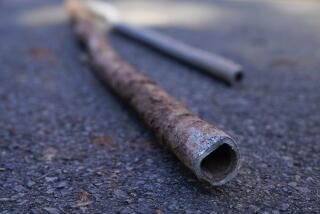Pros and Cons of Getting the Lead Out
- Share via
A large number of readers have written to Your Wheels recently to express concern about the upcoming reduction in the lead content of gasoline, which takes effect nationwide in July.
Many individuals who own older cars, which were designed to run on leaded gasoline, are concerned that the reduction in lead ordered by the government may damage the engines or degrade the performance of their cars.
Although there is no universal agreement about the effect of the reductions, especially on engine life, most experts believe that few problems will arise. But only time will tell whether the reductions will be cost-free.
Government Mandate
The government has mandated that gasoline refiners on July 1, 1985, reduce the lead content of gasoline from the current maximum of 1.1 grams per gallon to 0.5 grams per gallon. A second reduction occurs on Jan. 1, 1986, when the maximum allowable lead content goes to 0.1 grams per gallon.
Of course, “unleaded” gasoline contains no measurable lead, and owners of cars built since the mid-1970s that use unleaded gas are not affected. Lead can destroy the operation of catalytic converters in these cars.
Lead serves two functions in engines: It suppresses engine knock and, more importantly, it extends the life of intake and exhaust valves inside the engine.
The anti-knock qualities of lead can be duplicated with other additives at the refinery. Unfortunately, as any owner of a newer car knows, these don’t seem to work as well as lead. The ever-present “ping” in new-car engines usually means that the gasoline is detonating before it is supposed to. That’s irritating, but it’s usually not a major mechanical problem.
The more critical issue is valve wear. Before 1975, most automobile manufacturers relied on lead to lubricate or cushion the engine valves as they snapped shut on their seats inside the combustion chamber. Temperatures inside the engine reach as high as 700 to 800 degrees, and the lead forms a thin film on the surface of valves to protect them.
Without the lead, the valves, especially the exhaust valve, could wear into their seats in the cylinder heads. That results in “valve recession,” which translates into an expensive engine overhaul.
When the introduction of catalytic converters required unleaded gas, auto manufacturers started to harden valve seats to get by without lead. Most domestic auto makers started hardening valve seats in 1971, and foreign makers followed by 1973.
The potential problems arise in cars older than mid-1970s vintage with unhardened valve seats. The oil industry believes that the 0.1 grams of lead will provide adequate protection.
Neutral Authorities
Some neutral authorities, such as auto clubs, also say the reduced lead should not affect engine life. Honda, which was the last major manufacturer to stop building leaded-gas-burning engines (the last was 1979), also says the reduction will not be a problem.
But some American auto makers, particularly Chrysler, believe that shortened valve life is a distinct possibility. How much valve life is lost is an uncertainty.
Engines operated under very heavy loads with an open throttle or at very high engine speeds are likely to experience greater valve wear. Those conditions heat up the valves and can create a spinning motion of the valve against its seat.
Owners of these older cars should try to avoid hard operation. Short of that precaution, there is no additive that can duplicate the function of lead. Other gas additives only boost the octane, which can be achieved more economically by buying high-octane fuel at the pump.
Lead pollutes the atmosphere and has been tied to a number of human-health problems. So the bright side of this change is that in the long run, the new regulations will benefit everybody.
Ralph Vartabedian cannot answer mail personally but will respond in this column to automotive questions of general interest. Do not telephone. Write to Your Wheels, You section, The Times, Times Mirror Square, Los Angeles 90053.







